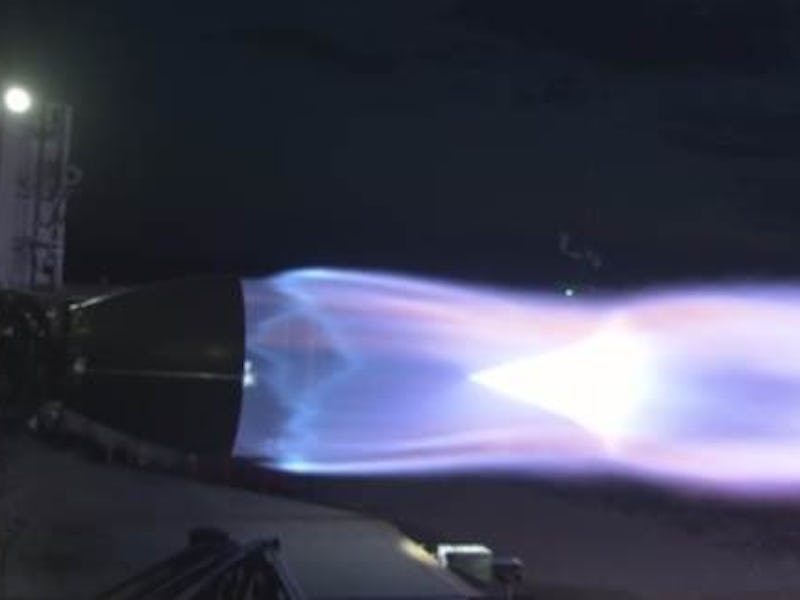SpaceX Starship: Elon Musk Says Its Next Breakthrough Is Only "Weeks" Away
The Mars-bound rocket could soon take flight.

Engineers working on Starship, SpaceX’s ambitious project to design to the world’s first Mars-voyage ready vehicle, resolved a key issue at the Boca Chica test facility in Texas over the weekend. That puts the Starship on track to move from hop tests to its first hover test, a testament to its long term viability and the next step toward taking its maiden flight.
“Exciting progress in Boca!” CEO Elon Musk declared on Sunday. “Hopper almost ready to hover.”
The landmark could mean that the ship, first unveiled in September 2017 under the name “BFR,” is almost ready to undertake a longer leap into the air. The ship uses seven Raptor engines fueled by liquid oxygen and methane. While the first full-sized design measured a staggering 348 feet tall in its original iteration, the miniaturized “hopper” version enables the team to test fewer engines before committing to a full-sized prototype.
The Starship "hopper" prototype.
Musk explained that the company plans to host a presentation about the Starship “a few weeks” after these next Hopper jumps, which would place the launch around late July. That’s a slight change from the plans announced in May, when he claimed a reveal could “probably” take place on June 20. Musk sweetened the pot by promising “free LJ chips for all present!”
“Local supporters will be invited!” Musk declared in response to questions from local enthusiasts like Austin Barnard and Evelyn Janeidy Arevalo.
Each Starship breakthrough helps pave the way for establishing humanity as a “multi-planetary species,” as Musk describes it. The use of liquid oxygen and methane, instead of the rocket propellant used by SpaceX in its more conventional rockets like the Falcon 9 and Falcon Heavy, looks ahead to when humans may one day need to be able to establish propellant plants in outer space. That means humans can travel to Mars over the course of three to six months, set up a fuel station and return home.
The Starship on Mars.
This plan, which also requires SpaceX to perfect its reusable rocket tech, could enable the travelers to explore further and set up a network of planet-hopping.
SpaceX Starship: Hopper Tests
The “Hopper” completed its first successful tethered launch, using a single Raptor engine, in April 2019. Since then, the team has been focused on achieving larger jumps, in preparation for building a full-blown orbital prototype.
“Based on tonight’s test, looks like 600 Hz Raptor vibration problem is fixed,” Musk explained.
The vibration problem in question may be linked to this strange noise seen in a static test fire:
NASASpaceFlight forum user “Crispy” noted that the “farting” sound seen at the end peaks around 600 Hz, suggesting this is the behavior Musk was aiming to fix.
Other changes since this launch include “a design improvement that could yield about 7 bar more.” Musk made reference to this change on June 24, suggesting that the company could improve on its previous records of 269 bar. That record, achieved during a February static test fire, beat the Russian-made RD-180.
Musk also suggested the company has made a number of minor improvements, which could become apparent as the firm holds more tests closer to launch.
“Between first development engine & first flight engine with operational payload, there are always hundreds of changes to both hardware & software,” Musk explained. “Over time, thousands.”
SpaceX aims to produce Raptor engines as fast as one every 12 hours. As the company has only produced six engines so far, this would be a dramatic boost in manufacturing. Each Starship requires nearly 40 engines once the Super Heavy booster is factored in, and since the company wants the Starship to act as a viable replacement for the Falcon 9 and Falcon Heavy, it could need all the engines it can get its hands on.
Earlier this month a representative revealed the first mission could come as early as 2021, likely sending up a telecommunications satellite. The company is also planning a trip around the moon for Japanese billionaire Yusaku Maezawa, and a manned mission that could require up to six Starships to set up the initial base.
From there, Musk has suggested a city on Mars could take shape as early as 2050. But before that can happen, Starship will have to learn how to hover as it has recently learned to hop.